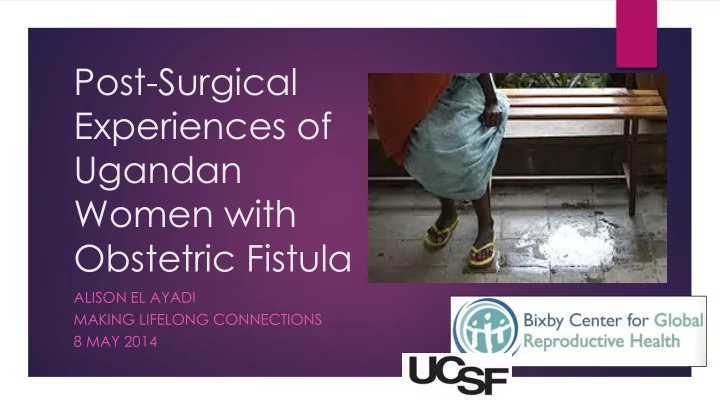

Post-Surgical Experiences of Ugandan Women with Obstetric Fistula ALISON EL AYADI MAKING LIFELONG CONNECTIONS 8 MAY 2014
Presentation Overview Work in Progress Background Study details
What is Obstetric Fistula? Childbirth injury due to prolonged obstructed labor Sexual violence or iatrogenic causes (surgeries) Pressure of baby’s head against maternal pelvis impedes blood flow to bladder, vagina and rectum Necrotic tissue sloughs, results in hole between adjacent organs Vesico-vaginal Fistula (VVF) Recto-vaginal Fistula (RVF)
Obstructed Labor Injury Complex Obstetric fistula associated with a wide range of gynecologic, skeletal, neurologic and dermatologic injuries Leaking urine and/or feces Scarring Pituitary and hypothalamic dysfunction Infection Vaginal and genital ulcerations Perineal and bladder nerve injury Foot drop Complex neuropathic bladder dysfunction High rates of secondary infertility
Psychological Sequelae of Obstetric Fistula 90% of infants die Depression, low QOL Lose economic productivity ability Stigmatization/marginalization Varies by context, length of time with fistula Divorce
Epidemiology of Obstetric Fistula Estimating incidence and prevalence difficult due to methodological challenges World Health Organization estimates 2 – 3 million women living with obstetric fistula world-wide, most in sub- Saharan Africa Approximately 100,000 new cases annually (1-2 per 1,000 deliveries) Causes Three Delays Model Reduced pelvic capacity/development
Study Rationale Focus on improving access to surgery over past decade 60 – 90% success rate of surgeries Success of fistula surgery defined as short-term clinical outcomes Assumption of social and emotional effects Residual incontinence Lower QOL of life with persistent incontinence Little attention has been paid to success of the surgery from the woman’s perspective Ability to reintegrate, regain previous roles
Sparse literature on post-repair reintegration Surgery leads to improved perceived quality of life Most women able to resume household and farming responsibilities Returning to work very important Ability to provide for oneself restored value as woman Lingering physical problems (e.g., residual incontinence, pain, fatigue) less able to resume previous roles What else matters Length of time lived with fistula Family support (economic and emotional)
Patients Treated for Obstetric Fistula (2011) Total Patients Treated (2011) Source: Direct Relief, Global Fistula Map(www.globalfistulamap.org)
Ugandan Context Population 33.5 million, 25% below national poverty line Est. 240,000 prevalent fistula cases, 2.0% lifetime prevalence among women aged 15 - 49 Chronic health system shortages Total fertility rate 6.2 MMR: 438 per 100,000 live births 41.6% births at home, 3.1% births cesarean 47% facilities have emergency transport Ugandan national Fistula Technical Working Group
Study Aims 1. To understand the process of family and community reintegration post fistula surgery. 2. To develop, pilot test and modify a measurement tool to assess long- term success of family and community reintegration among women returning home after obstetric fistula surgery. 3. To assess the feasibility of long-term follow-up of reintegration after fistula surgery utilizing mobile phone technology
Methods – Qualitative Component Eligibility criteria: Obstetric fistula surgery 6 – 24 months previously Reside within 100 km of Mulago Hospital Luganda or English Capable of providing informed consent 15 in-depth interviews 4-6 focus groups
In-depth Interviews Normal life prior to development of obstetric fistula Pregnancy and delivery leading to obstetric fistula Changes to normal life due to obstetric fistula Care-seeking experience for obstetric fistula Experience of healing from the fistula surgery and returning to normal life Supports/challenges Hopes and goals Mental health throughout
Focus Groups How did having the fistula affect role within family and community How did having the fistula repair affect role within family and community Supports/challenges
Measurement Tool Development Return to Normal Living Index Quality of Life (WHO) Qualitative results will inform tool development/modification Tool to be tested within a small longitudinal sample
Methods – Quantitative Component Desired sample size: 60 women Eligibility criteria: Confirmed imminent or completed obstetric fistula surgery Reside in area with cellular coverage, or consistent travel to such area (e.g., weekly market) Data collection periods: baseline, 2 weeks, 3 mo, 6 mo, 9 mo, 12 mo Baseline and 2 weeks: in hospital, in person collection All other f/u periods: via mobile phone
Tool Validation Reliability Internal consistency reliability ( ) Temporal stability (Baseline – 2 weeks) Validity Construct validity Other measures Depression, QOL, self-esteem Confirmatory factor analysis Long-term outcomes
Next Steps Current: collect data! Validate tool in other cultural contexts Use qualitative information to inform intervention programming Use of tool within intervention framework
Thank you! Alison El Ayadi elayadia@globalhealth.ucsf.edu
Recommend
More recommend